Airborne self-propelled gun ACS-85
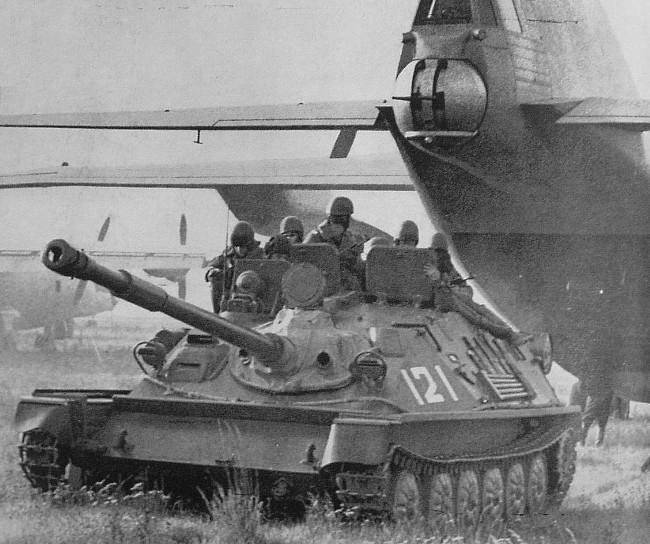
For many years, the standard self-propelled anti-tank gun of the Soviet Airborne Forces was the ASU-57. Its deafening success gave the Soviet command a desire to get hold of also an average self-propelled gun, equipped with an 85-millimeter cannon. In this regard, in 1951, at the Mytishchi machine-building plant, they began to develop a project for a new self-propelled artillery unit. This development involved in OKB-40. The works were supervised by Nikolai Alexandrovich Astrov - the creator of the T-29, -38, -40, -60, -70 and -80 tanks.
According to the original design of Astrov, the projected self-propelled guns (developed under the designation “Object 573”) were supposed to use the mechanisms and components of the PT-76 light amphibious tank, but the customer and the Council of Ministers representatives expressed a strict demand for the widespread use of automotive units. In particular, the B-6 diesel engine, mastered by industry and well-proven in operation in the military, was replaced in the designed power compartment by the YAMZ-206 two-stroke automobile diesel engine produced by the Yaroslavl Motor Plant.
A prototype self-propelled artillery mount produced in the middle of the 1950-x. Serial production of self-propelled gun which received the designation SU-85 began in the year 1959. In part of the airborne troops the machine came under the designation of ACS-85. Serially produced at MMZ in 1959-1966. During this period, released a little more than 50 pieces.
The layout of the ASU-85 self-propelled gun: the control compartment was located in front (there is a driver's seat); in the middle was the fighting compartment; engine compartment - in the stern. One after another, to the right of the cannon there were places for the loader and the commander. Place gunner was to the left of the gun.
Body self-propelled - box. For the hull used rolled armor plates installed at rational angles of inclination. Frontal tilted 45 degrees and protects the crew from armor-piercing projectiles of medium and small caliber. To the left of the longitudinal axis of the self-propelled guns in the front embrasure sheet for the D-70 cannon and the SGMT machine gun paired with it (covered with armor), to the left are the observation instruments of the driver. On the edges of the frontal sheet mounted headlights equipped with a blackout nozzles in the fence. The roof of the fighting compartment is welded, to the sides of the part it is attached with riveting. The driver’s hatch is made in front of the right; on a small turret in front of him a headlight. The HLF input to the left of the hatch. On the roof of the fighting compartment behind are two identical quadrilateral hatches. A driver's viewing device is installed on the right cheekbone of the fighting compartment, on the left - a handrail for landing. Close to the gunner's hatch on the left side is the viewing device B-1, underneath it there are loopholes and a bannik and a tarpaulin attachment bracket. On the roof of the engine compartment there are two corrugated hatches, a filler cap and blinds. Spare parts boxes, a pair of smoke bombs БДШ-5 are installed on the feeding sheet. The corrugated bottom has an emergency exit hatch.
Despite the fact that the car was developed on the basis of a floating tank, the SAU does not float, however, it can overcome fords without preliminary preparation, the depth of which is up to 1,1 m. A couple of additional fuel tanks are installed at the stern of self-propelled guns.
As mentioned earlier, the USSR Council of Ministers demanded that car units be used on the ACS-85. To provide the necessary specific power of the 6-cylinder, V-shaped, two-stroke 210-strong automobile diesel engine YMZ-206В, they introduced a cumbersome, but not requiring extra energy expenditure ejection cooling system. The engine compartment was made smaller by installing the engine across the hull. There was also placed a mechanical transmission, which consisted of the main friction clutch, gearbox, gearbox, propeller shaft, final drives and planetary turning mechanisms. It turned out that the single-plate clutch turned out to be unreliable, and already during the operation of the self-propelled guns in parts it was replaced by a specially designed multi-plate friction clutch. The insufficient rigidity of the shafts of the automobile five-speed gearbox required thorough processing, after which only some of the original parts “survived”.
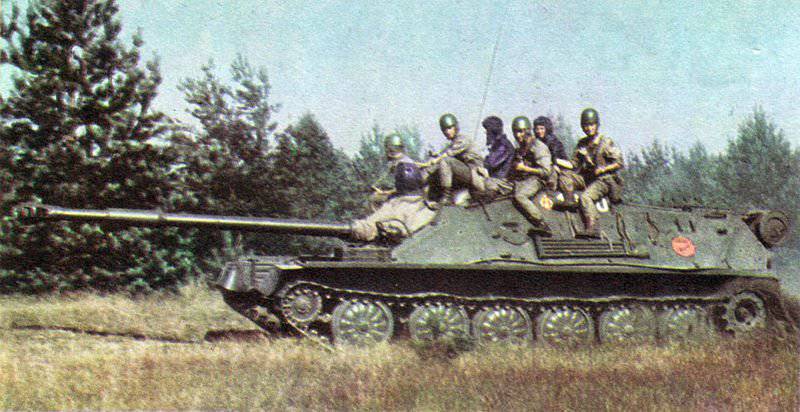
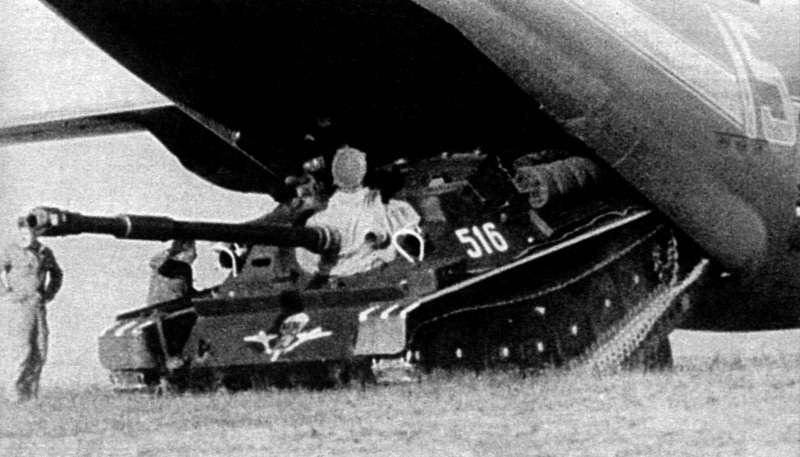
The tracked propulsion unit consisted of two leading rear wheel, two guide wheels with mechanical tension of the chains, twelve single-row rubber-coated support rollers of medium diameter and metal track chains. Suspension - individual, torsion with piston-type hydraulic shock absorbers on the rear and front nodes.
The armament of an airborne self-propelled unit ASU-85 is a X-NUMX-millimeter D-85 gun equipped with a two-chamber muzzle brake, an ejector, and a vertical wedge gate with copy-type semi-automatic. The gun is slightly shifted to the left relative to the longitudinal axis of the self-propelled gun. Hydraulic recoil brake - spun with compensator; Knurled - pneumatic. A hand-operated sector lifting mechanism provides elevation angles ranging from -70 to + 5 degrees. Horizontal guidance - 15 degrees. Sights: articulated telescopic - TSHK-30-2-79, panoramic for firing from closed positions - С-11-71, night sight - ТПН-79-1-79.
Ammunition consisted of 45 unitary shots. The 7,62-mm machine gun SGMT, the ammunition load for which is 2000 cartridges, placed in 8 box-stores, is placed on the unit to the right of it mounted to the gun. There were shots in the fighting compartment: at the MTO partition in the niche - 14, along the partition - 8, at the left side - 7, in the niche of the left side - 5, in the niche of the right side - 6, in front of the gunner - 5. In addition, the crew had at its disposal 15 hand grenades F-1, 300 ammunition for AKMS, and 20 signal ammunition for the signal pistol SSPH 20 caliber mm.
Ammunition standardized with ammunition gun D-48.
The transported ammunition consisted of 21,8-kg unitary shots with projectiles of several types. These included high-explosive fragmentation grenades UO-365K (mass 9,54 kg, initial speed 909 m / s). They were intended for the destruction of fortifications and the destruction of enemy personnel. For firing at mobile, armored targets, self-propelled guns and tanks - sharp-headed armor-piercing tracer shells Br-365К were used (weight 9,2 kg, initial speed 1150 m / s). These shells could fire at a distance of 1,2 km. Blunt-headed armor-piercing tracer shells of Br-365 with a ballistic tip could hit targets at a distance of up to 1,25 km. In addition, for the destruction of tanks and armored personnel carriers from a distance of 1,6 - 2,5 km, armor-piercing-tracer sabot shells Br-367P and Br-367PK (mass 4,99 kg, initial speed 1150 m / s) were used. At a distance of 2 km, an armor-piercing projectile pierced the armor with a thickness of 53 millimeters placed at an angle of 60 degrees, and the cumulative projectile - 150 millimeters. The maximum range of high-explosive fragmentation projectile - 13,4 km. In addition to the self-propelled ammunition ammunition, they included U-367 smoke shells with a steel body. They were used to blind the observation and command posts of the enemy, his batteries, firing points and individual guns. They also used to target gunners.
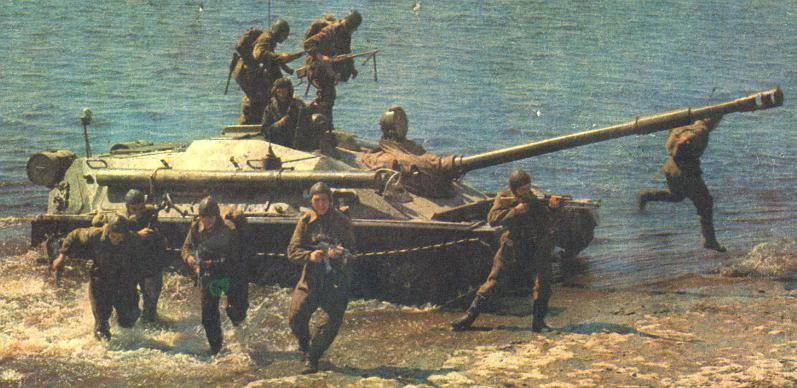
Communications equipment - TPU P-120 and radio station P-113. Self-propelled gun is supplied with an automatic PAZ system. There is also a sealing system for habitable compartments.
In 1970-ies, the ACS-85 was modernized: a cylindrical commander's turret was installed on the roof of the fighting compartment with a periscope observation device TNPK-240А and a gun panorama. On top of the turret there was a hatch, on the turret in front of which the anti-aircraft machine gun DShKM was mounted. Behind the commander's turret, a slot was cut in the vertical stern sheet, a viewing device was installed.
ASU-85 was usually transported by the military transport An-12 and landed with the help of special parachute systems. The gun was mounted on a platform to which several parachutes were attached. Before contact with the ground, special brake rocket engines began to work, and the self-propelled unit landed safely. After unloading the machine was transferred to the combat position of the marching and vice versa for 1-1,5 minutes, which is necessary for an artillery system of a similar purpose.
In addition to the USSR, these self-propelled units were supplied to Poland (31 ASU-85 in 1965 year) and GDR (20 machines in 1964 year).
ASU-85 participated in the 1967 year in the Arab-Israeli conflict, which is known as the “Six Day War”. It was this combat use that revealed the need to install an 12,7-caliber anti-aircraft machine gun DShKM on the wheelhouse.
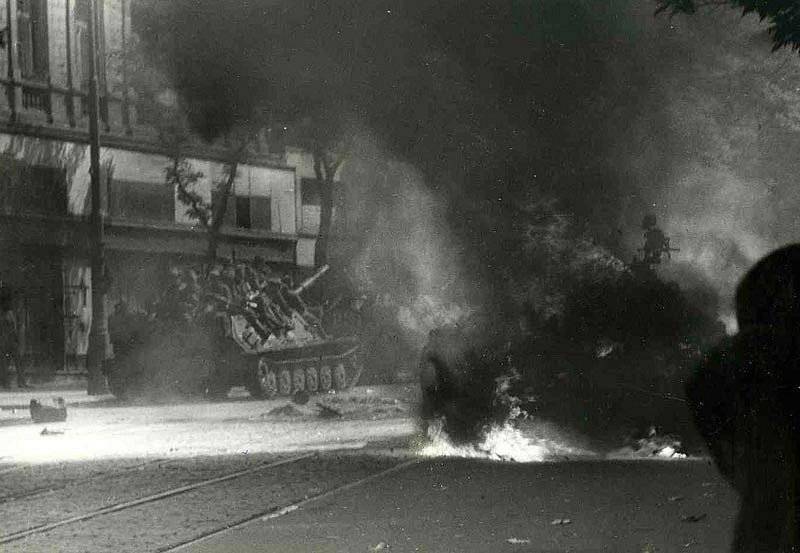
ТActing-technical characteristics:
Combat weight - 15,5 t;
Crew - 4 person;
Body length - 6240 mm;
Length with a gun forward - 8435 mm;
Case width - 2970 mm;
Height - mm 1935;
Base - 3808 mm;
Track - 2580 mm;
Clearance - 420 mm;
Reservation
The forehead of the body is 45 mm / 60 degrees;
Chassis side (top) - 13 mm / 40 degrees;
Chassis side (bottom) - 15 mm / 0 degrees;
Body Feed - 6..8 mm;
Bottom - 4..6 mm;
The roof of the housing - 6 / 90..13 / 70 mm;
Armament:
Caliber and brand of gun - 85 mm 2А15;
Type of gun - rifled gun;
Barrel length - 68 calibers;
Gun ammunition - 39;
Vertical guidance angles - −4,5… + 15 degrees;
Horizontal guidance angles - ± 15 degrees;
Firing range - up to 10 km;
Sights - telescopic TSHK-2-79, night passive TPN-1-79-11;
Machine guns:
14,5 mm DShK;
7,62-mm SGMT;
Mobility:
Engine type - YAZ-206В;
Engine power - HP 210 .;
Highway speed - 45 km / h;
Speed over rough terrain - 25..30 km / h;
Cruising on the highway - 360 km;
Cruising over rough terrain - 230 km;
Power density - 13,2 hp / t;
Suspension type - torsion, individual;
Ground pressure is 0,57 kg / cm²;
Overcoming rise - 30 grad .;
Breakable wall - 0,7 m;
Overcoming ditch - 2,5 m;
Overcoming ford - 1,1 m.
Based on materials:
http://opoccuu.com
http://zonawar.ru
http://www.dogswar.ru
http://army.lv
http://armoredgun.org
http://russianarms.mybb.ru
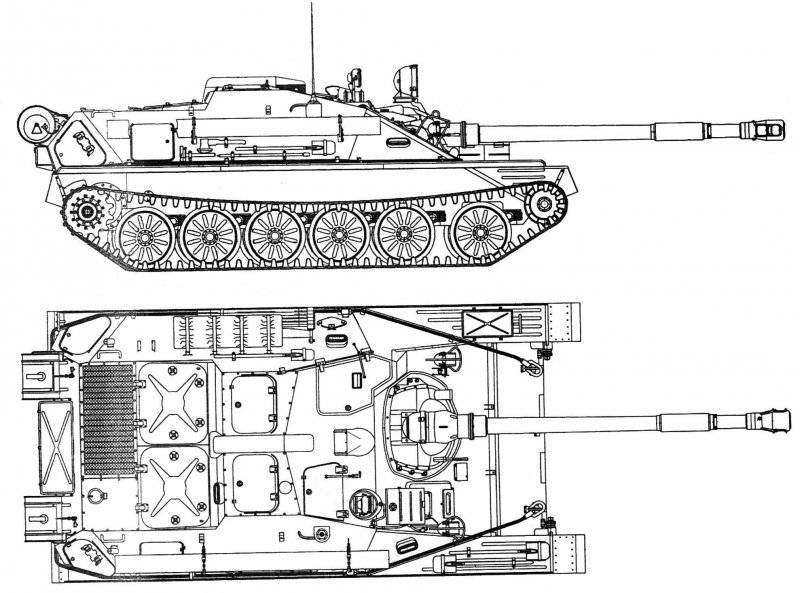
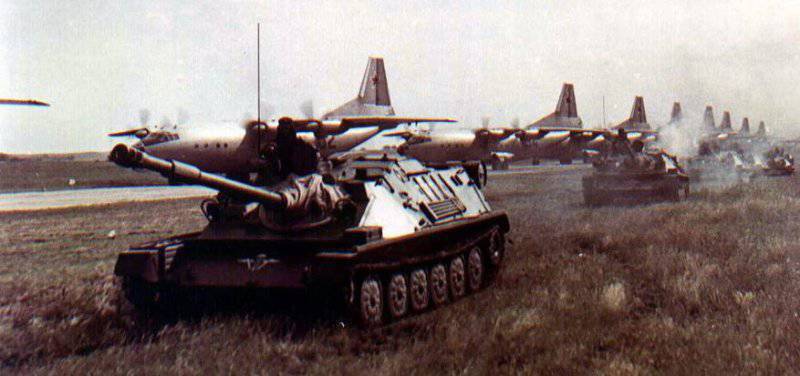
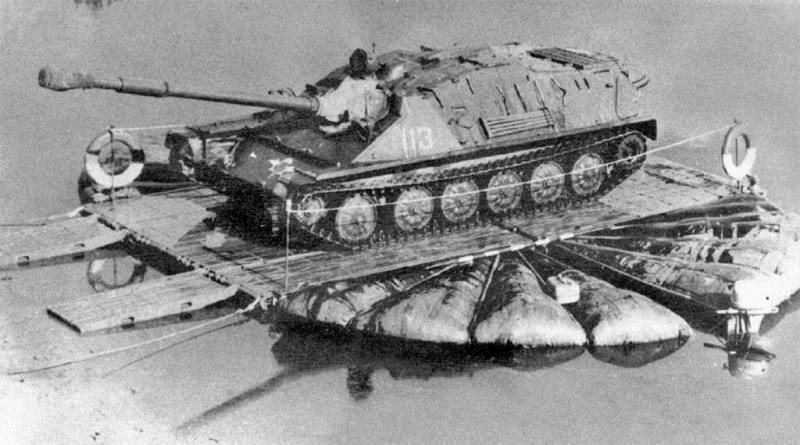
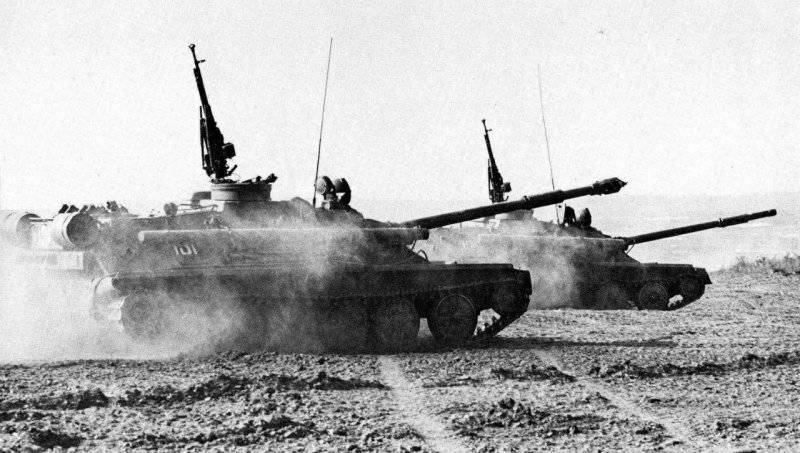
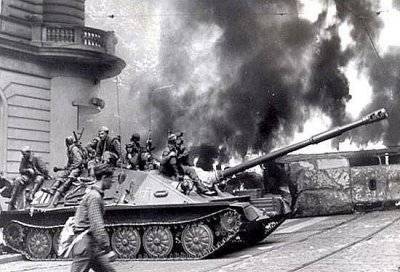
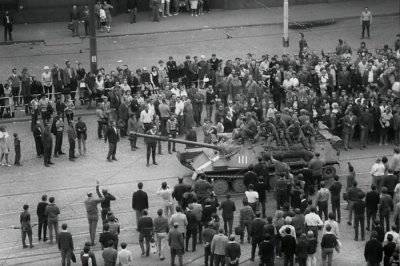
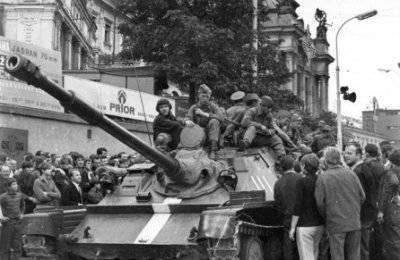
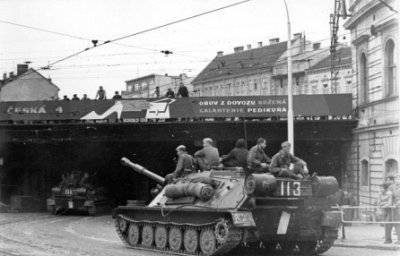
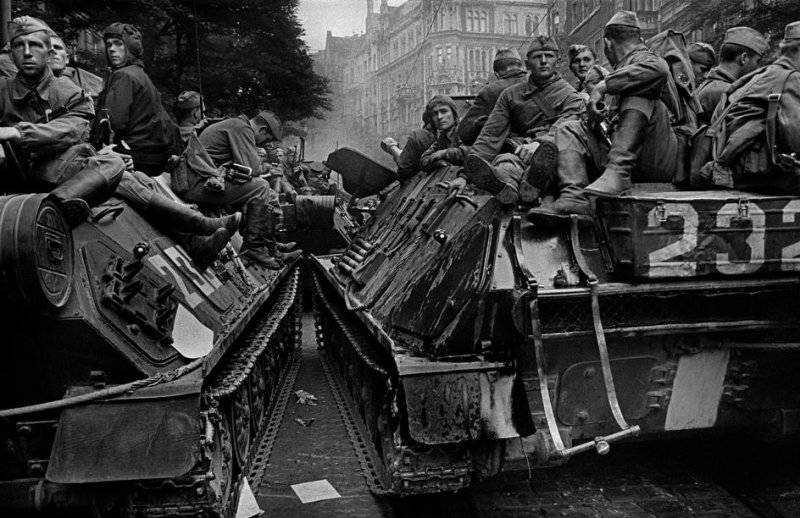
Information